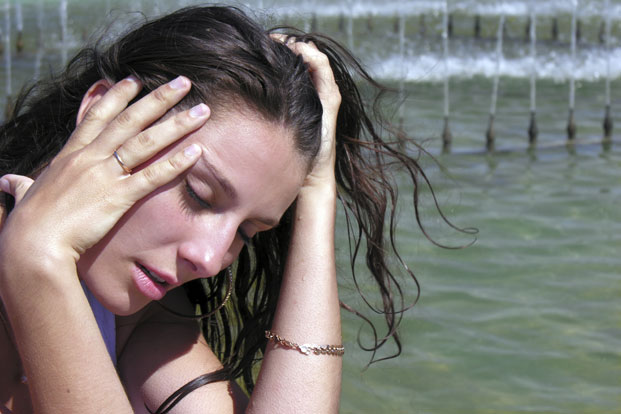Whether at the beach or in the garden, warm weather seems the ideal climate for spending time outdoors. But too much “sun” can pose a serious health risk. It doesn’t matter if time outside is for work or leisure: you may be at risk of a serious heatstroke.
According to the National Oceanic and Atmospheric Administration, an average of 175 Americans each year die of heat-related illness. Perhaps the most severe form of such heat-related illnesses is heatstroke, a very severe and potentially fatal condition.
Jake Deutsch, MD, considers heatstroke to be one of the most dangerous forms of heat-related illness. “In effect, the master circuits of the body’s “computers” have shut down,” says Dr. Deutsch. “This (can lead) to circulatory collapse, seizure, and coma. It’s a true life-threatening emergency.”
If you or someone else intends to spend a prolonged period outdoors in extremely hot weather, it’s important to understand heatstroke risks and the symptoms of a possible heatstroke.
What’s a heatstroke and why does it happen?
A heatstroke is a condition where the body becomes overheated. Under normal circumstances, the body copes with exposure to heat by actively cooling the body down. Many people mistakenly credit sweating with keeping the body cool. In fact, it’s the evaporation of sweat that is essential for helping to prevent heat illness. This regulates the body’s temperature.
When the body’s internal temperature exceeds 104 degrees Fahrenheit, it’s very possible a heatstroke can occur.
Conditions That Raise Heatstroke Risk
One should be knowledgeable about conditions and behaviors that drastically increase the risk of heat stroke. While some people are more vulnerable to sunstroke than others, anyone can be affected. Read through these risk factors and carefully reconsider any activity that would put yourself or others in danger. They are as follows:
AGE – Age can be a very strong risk factor in determining heatstroke vulnerability. The persons most at risk tend to be very young (age 4 or younger) or of advanced years (older than age 65).
OBESITY – Obesity is an issue because it often means that the body cannot adequately regulate its temperature in extreme heat. This condition makes obese men and women very vulnerable to heatstroke.
PRE-EXISTING MEDICAL CONDITIONS – Men and women with cardiovascular, respiratory, or renal diseases can be very susceptible to heat-related illness.
DEHYDRATION – Failure to drink enough liquids prior to or while outdoors in exceedingly hot weather is hardly ever advisable. The body can lose fluid rapidly in these conditions.
MEDICATIONS: Certain medications can cause dehydration as a side effect or affect the ability of the body to perspire as needed. It’s important to consult a doctor or pharmacist about how certain medicines can affect your risk of heatstroke.
ALCOHOL: Alcoholic beverages can interfere with the body’s temperature regulation. Using beer, wine, etc. to “stay cool” while in hot weather isn’t a good idea. Water or fruit juices tend to work much better.
In addition to these conditions, certain behaviors can also increase the risk of heatstroke.
Wearing too many clothes. When temperatures get dangerously hot, it is important to dress accordingly. You should avoid layers whenever possible, and opt for shorts and short-sleeved shirts.
Strenuous activity. Try not to overexert yourself when faced with extremely warm conditions. If you must work outside in the heat for long periods, be sure to stay hydrated. Also, let others know where you’ll be and what you’ll be doing so that someone can check on you occasionally.
What are the symptoms of a heatstroke?
One of the very first warning signs of a heat stroke is a very high body temperature. Usually, a fever of 104 degrees indicates the possible onset of heatstroke. Other warning signs of a heatstroke include:
Confusion or disorientation
Skin that is dry, hot, or red in color
Rapid and shallow breathing
Rapid but weak heart beat
Nausea or vomiting
Seizures
Loss of consciousness
What To Do If You Suspect Heatstroke
A heatstroke is a very severe and potentially fatal condition. If you or someone else appears to feel the effects of a heatstroke, you are advised to call 9-1-1 immediately. While you wait for medical assistance, it’s important to work to cool down the person or persons suffering from heatstroke.
Get them to shade or take them indoors, out of the heat
Remove any excess clothing
Put them in a tub of cool water, a shower, or spray them with a garden hose.
Wet towels or ice packs can be placed around the person’s head, neck, underarm, and groin areas.
Please note that certain treatments will NOT relieve heatstroke symptoms and could actually make the situation worse! They include:
Do not give someone having a heatstroke aspirin or any medication used to treat fevers.
Do not have the person ingest liquids that contain alcohol or caffeine. If they are vomiting or unconscious, you should not give them anything to eat or drink.
Avoid putting alcohol rubs on their skin.
Preventing Heatstroke
The best way to prevent a possible heatstroke is to be mindful of risk factors and to behave accordingly.
Wear light-colored, loose clothing made from light-weight materials.
If you will be outside for an extended amount of time, know what the temperature will be for most of the day.
Be sure that you stay hydrated and always have access to fluids, especially water.
Try to spend time in a shaded area as often as possible.
Avoid sitting in hot cars for a prolonged periods of time. Do not leave children or seniors in hot cars.
Try not to perform demanding physical activities in extreme heat.
Be knowledgeable about heatstroke causes and symptoms and seek immediate medical attention if you are someone else is affected.
Do not underestimate the effects of severely hot temperatures on the body. Instead, be mindful of the weather and any associated risks. A knowledgeable, proactive approach can greatly reduce your heat stroke risk.

Leave a Reply